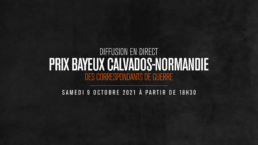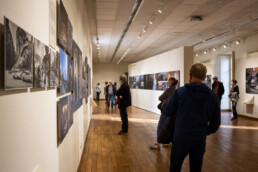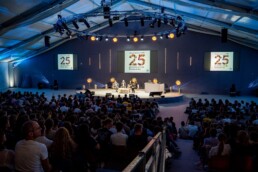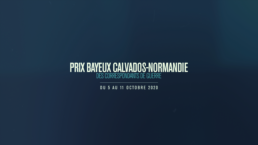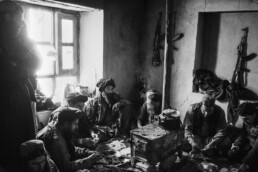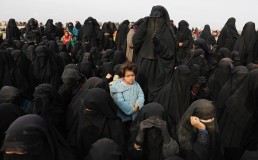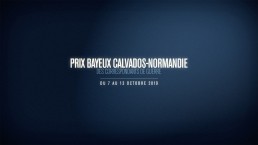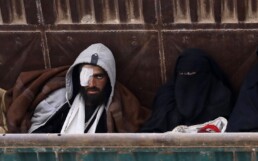28th edition of the Bayeux Calvados-Normandy Award: results
More than forty war correspondents have gathered in Bayeux on October 8th and 9th to debate and award trophies in the following categories: photo, print, radio, television, grand format television, young reporter (written press) and video image. Three honorary awards have been attributed: the Regional prize for students and trainees of Normandy (television), the Public’s Choice award (photo) and the Ouest-France – Jean Marin prize (print). Presided by Manoocher Deghati, the international jury of the 28th edition of the Bayeux Calvados-Normandy Award for war correspondents has reached its verdict…
“It is exceptional to bring together forty professionals here in Bayeux. The debates are incredibly rich. For us, war reporters, who never have time to talk to each other when we are in the field, this moment is an opportunity to discuss, judge and look at our work and our colleagues’. These reports are the result of our experiences and the best of the profession.“
Manoocher Deghati
PHOTO TROPHY – INTERNATIONAL JURY
AWARDED BY NIKON
1st Prize
Anonymous Burmese photographer
for The New York Times
La révolution du printemps
MYANMAR
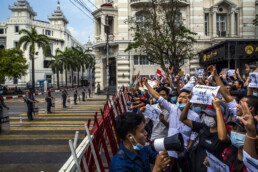
2nd Prize
Mohamed ABED
AFP
Gaza : 11 jours de bombardements
GAZA
3rd Prize
Laurent VAN DER STOCKT
Le Monde
Un mois de soulèvement palestinien
ISRAEL, OCCUPIED WEST BANK, EAST JERUSALEM, GAZA
TELEVISION TROPHY – INTERNATIONAL JURY
AWARDED BY AMNESTY INTERNATIONAL
1st Prize
Orla GUERIN and Goktay KORALTAN
BBC
Les tireurs d’élite au Yémen
YEMEN
2nd Prize
Nick PATON WALSH and Christian STREIB
CNN
Au Belarus, ils voulaient la démocratie. Au lieu de cela, ils disent qu’ils ont été battus et violés par la police.
BELARUS – UNITED KINGDOM
3rd Prize
John SPARKS ans Garwen McLUCKIE
SKY NEWS
La route de Cheli
ETHIOPIA
PHOTO TROPHY – PUBLIC’S CHOICE AWARD
SPONSORED BY THE FRENCH DEVELOPMENT AGENCY (AFD)
1st Prize
Abu Mustafa IBRAHEEM
Reuters
Gaza : 11 jours de bombardements
GAZA
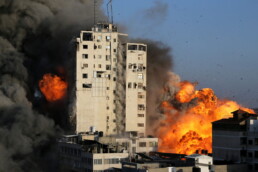
PRINT TROPHY – INTERNATIONAL JURY
AWARDED BY THE DEPARTMENT OF CALVADOS
1st Prize
Wolfgang BAUER
Zeit Magazin
Among Taliban
AFGHANISTAN
2nd Prize
Rémy OURDAN
Le Monde
Guerre au Karabakh
STEPANAKERT, NAGORNO-KARABAKH
3rd Prize
Samuel FOREY
Libération
De Jérusalem à Gaza, Palestine et Israël s’embrasent
JERUSALEM, LOD, ASHKELON, GAZA
RADIO TROPHY – INTERNATIONAL JURY
AWARDED BY THE D-DAY LANDING COMMITTEE
1st Prize
Margaux BENN
EUROPE 1
À Kandhar, des villages entiers sont devenus terrains minés
AFGHANISTAN
2nd Prize
Omar OUAHMANE
FRANCE INTER
Un carnage, deux versions : témoignages après les frappes meurtrières de Bounti
MALI
3rd Prize
Céline MARTELET and Edith BOUVIER
RTS
Des familles syriennes à la recherche de leurs proches
SYRIA
YOUNG REPORTER TROPHY (WRITTEN PRESS) – INTERNATIONAL JURY
AWARDED BY CRÉDIT AGRICOLE NORMANDIE
1st Prize
Thomas D’ISTRIA
Le Monde
Révolution dans la dernière dictature d’Europe
BELARUS
GRAND FORMAT TELEVISION TROPHY – INTERNATIONAL JURY
AWARDED BY BAYEUX CITY
1st Prize
Damir SAGOLJ and Danis TANOVIC
Al Jazeera Balkans
When we were them
BIHAC, BOSNIA-HERZEGOVINA
VIDEO IMAGE TROPHY – INTERNATIONAL JURY
AWARDED BY ARTE, FRANCE 24, FRANCE TÉLÉVISIONS
1st Prize
Damir SAGOLJ and Danis TANOVIC
Al Jazeera Balkans
When we were them
BIHAC, BOSNIA-HERZEGOVINA
PRINT TROPHY – OUEST-FRANCE – JEAN MARIN
1st Prize
Wolfgang BAUER
Zeit Magazin
Among Taliban
AFGHANISTAN
TELEVISION TROPHY – REGIONAL PRIZE FOR STUDENTS AND TRAINEES OF NORMANDY
1st Prize
Orla GUERIN and Goktay KORALTAN
BBC
Les tireurs d’élite au Yémen
YEMEN
Manoocher Deghati, Jury Chair for the 28th edition
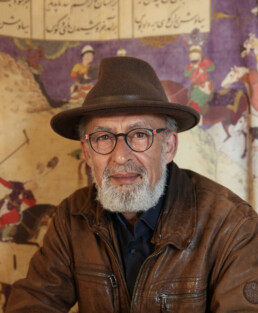
© Clara Deghati
Manoocher Deghati is 67. He is a photojournalist, war correspondent and teacher. But first and foremost Manoocher is an Iranian. And he has not seen his native country for over 35 years.
“I was destined to become a photojournalist”
“I was destined to become a photojournalist”
It all began in 1978. The young Manoocher, who had spent four years in Rome studying cinema with the ambition of becoming a cameraman, returned home to Iran. At that time there were rumblings of revolt: the people were rising up against the Shah and his repressive policies. Students had taken to the streets demanding greater freedom and democracy. As the production of films for cinema had come to a halt, Manoocher grabbed his equipment and went out to record the history of his country for posterity. Armed with his camera and a few rolls of film he photographed demonstrators and soldiers, and began working for the Sipa Press agency and AFP. The first accolades followed – he was awarded the World Press first prize in 1984 – and so did the first repressive measures: his photos of child soldiers and executions irritated the authorities. He was imprisoned, beaten and threatened. His press card was confiscated several times. In 1985 the risks had become too great and Manoocher decided to flee his country. He went into exile in France with his wife and his daughter Maral, who was only one year old at the time. This was the beginning of a long journey and a long career all over the world, sometimes marked by incredibly fortuitous timing.
“I never really had time to think about changing jobs”
“I never really had time to think about changing jobs”
After he had spent a few months in Paris, AFP asked Manoocher to take part in developing their international bureaus. He decided to go to Central America “in order to get away as far as possible from the Middle East”. Based in Costa Rica, he worked with local photographers covering the wars and social crises that were raging in Guatemala, Nicaragua and El Salvador, and he was in Panama during the invasion by the United States in 1989. After Iran, this was the second time Manoocher had found himself at the heart of the news. At the beginning of the 1990s he took over as bureau chief for AFP in Cairo, where he covered the Israeli-Palestinian conflict in particular. The photojournalist once again found himself in the thick of the news when Yasser Arafat returned to Palestine after 27 years of exile. Jerusalem, Somalia, the Gulf War, the siege of Sarajevo…Manoocher’s career continued but was temporarily halted in 1996 when an Israeli sniper shot him in the leg in Ramallah. He was very seriously wounded and had to be repatriated to France, where he spent 18 months in the military hospital of Les Invalides – the only civilian among all the veterans. He sorted his photos in his room, producing features for AFP. During his stay there he received a visit from President Jacques Chirac: he granted him French citizenship, which would make international travel much easier from then on. On his return to the field, Manoocher covered official visits abroad by the French Government. In 2000 he was a victim of the controversial visit by Lionel Jospin to Palestine: he was hit on his weakened leg by the Prime Minister’s car as it was fleeing from the stones being thrown. It was the same story again: repatriation, Les Invalides and a forced break. But in spite of the risks, Manoocher felt he had a mission and refused to give up taking photographs, speaking out and bearing witness. He had understood for many years that “photographs make an impact, they enable society to be told, they give a voice to the voiceless”.
“Taking photos of the living, the will to live, the hope”
“Taking photos of the living, the will to live, the hope”
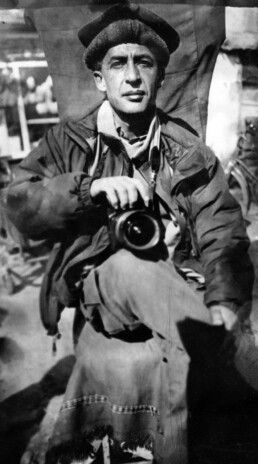
© Fardin Waezi
Always driven, Manoocher continued to cover the conflicts that marked the beginning of the 21st century, and notably the war in Afghanistan. It was there that he began a new career alongside his brother Reza, also a photojournalist: he became a teacher. In this “totally devastated” country the two men created an NGO called Aina and provided the benefit of their experience to young Afghans. The school has trained many journalists since its creation and has enabled new publications to be disseminated. Manoocher was later called upon by the UN to become a teacher within IRIN, the United Nations humanitarian press agency. Based in Nairobi, he would train more than a hundred photographers. In January 2011, with a career of 30 years behind him, he became head of Associated Press’ photography department in Cairo. Once again, his taking up of a new position coincided with a burning topic of news: the Arab Spring erupted barely 36 hours after his arrival. Egypt, Syria, Libya, Yemen, Iraq…one outbreak of demonstrations and uprisings followed another. Manoocher was managing 150 photographers and the media coverage was so dense that he was only getting 4 or 5 hours of sleep a day. Speaking several languages, he held the keys to working in this part of the world. One of his teams, of which he was head, would receive the prestigious Pulitzer Prize in 2013 for its report on Syria.
“There’s not really such a thing as retirement if you’re a photojournalist!”
“There’s not really such a thing as retirement if you’re a photojournalist!”
As the situation in Egypt was becoming more and more dangerous for journalists, Manoocher and his family left the country. He was tired, and in 2014 he decided to settle in the Apulia region of Italy. He bought a farm where he grows vines. He continues his career as a photographer surrounded by his family and his many animals, but far from war zones. In October 2021 he will be Jury Chair for the 28th Prix Bayeux Calvados-Normandie. The man who embraced his destiny with a career spanning 45 years as a photojournalist modestly calls this “A great honour”.
A FEW DATES
1954 ❱ Born in Urmia, Iran
1980 ❱ American Deadline Press Club, Special Achievement prize
1984 ❱ World Press, first prize in the news category for his photos of the Iran-Iraq war
1986 ❱ World Press Photo, third prize
2002 ❱ Set up Aïna, photography school in Kabul, Afghanistan
2004 ❱ Howard Chapnick Award for Advancement of Photojournalism
2012 ❱ Jury member, World Press Photo
2019 ❱ Publication of Iran : Rêves et dérives (Iran: Dreams and Excesses), co-published with his brother Reza, with texts by Rachel Deghati
2020 ❱ Publication of Eyewitnessed, a biographical work written by his wife Ursula Janssen, an archeologist and writer
Visual
The 2021 visual is a photo from the 2020 winning report. This photograph taken by Lorenzo Tugnoli from Contrasto for The Washington Post, was part of his report shot in Afghanistan between November 2019 and February 2020.
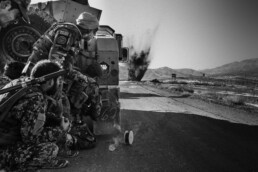
Caption: GHAZNI, AFGHANISTAN – DECEMBER 2:
A demining team of the Afghan national army detonate an Improvised explosive device that have been found on the Ghazni-Kandahar highway. A team from camp Sultan search this road for IEDs on a daily basis and often found one or many that have been set up by the Talibans the night before. Improvised explosive devices are one to the leading cause of casualties among civilians and members of the Afghan security forces.
Lorenzo Tugnoli
Lorenzo Tugnoli is an Italian photographer based in Lebanon who covers the Middle East and Central Asia. His work is an ongoing exploration of the humanitarian consequences of conflicts in the region. In 2014 he published “The Little Book of Kabul”, a book project that depicts a portrait of Kabul through the daily life of a number of artists who live in the city, in collaboration with writer Francesca Recchia.
He is a contract photographer for The Washington Post and his work has been published by The New York Times, The Wall Street Journal, and Time Magazine among others.
He joined the photography agency Contrasto in 2017.
Lorenzo is the 2019 Pulitzer Prize Winner in Feature Photography, and was awarded the 1st prize in General News Stories for the World Press Photo in the same year.
In 2020 he was awarded the 1st prize in Contemporary Issues Stories for the World Press Photo and the 2nd prize for Issue Reporting Picture Story at the PoY.
© Bayeux Award photo 2020 – Lorenzo Tugnoli
“Traces of Humanity”
—
An exhibition by Rémy Ourdan and Damir Sagolj
Hôtel du Doyen
Exhibition design: Laurent Hochberg
4 October to 21 November 2021
—
Through the history of the Jews of Sarajevo and their neighbours, here is journey that retraces a particular notion of co-existence, dignity and courage. Or, as they say in Sarajevo, a certain idea of “neighbourhood”.
What does it mean to be neighbours during the darkest moments endured by a city, a society, or a nation? What does it mean to become a Righteous in time of war?
In order to create this multimedia exhibition, inspired by a series of articles published in Le Monde in 2019 – an exhibition that combines journalistic reports, historical documents and artistic works, reporters Rémy Ourdan and Damir Sagolj travelled through two cities that symbolise the peoples of the Book and the rifts in today’s world. On one hand there is Sarajevo, the last “Jerusalem of Europe” and the first target of the return of nationalisms on the Old Continent, besieged at the end of the 20th century; and Jerusalem, centre of the world, holy city of the three monotheistic faiths and the epicentre of the turmoil in the Middle East and the Israeli-Palestinian conflict. Two cities that have captured the world’s attention and tell a universal story.
In Sarajevo, to start with the arrival of the Jews from al-Andalus, than go to the Purim revolt and the rescue of the precious Haggadah book, than evoke the help given to Jews during the Holocaust as well as the help provided by Jews to the other besieged people during the Bosnian war: this journey in the footsteps of men and women who placed their universal existential values above any conflict related to identity, politics or religion. By recounting these episodes in the history of the Jews of Sarajevo and their Bosniak, Serbian or Croatian neighbours, the authors seek to shed light on traces of humanity.
A tribute to the Righteous.
A tribute to an art of living.
Photo illustrating the article: exhibition at the Hotel du Doyen during the 2020 Bayeux Award event © Julien Buyck – Prix Bayeux 2020
The Nikon Encounters, new meeting

The Nikon Meetings
This year’s Nikon Encounters will take place on Friday 8 October at la Halle ô Grains in Bayeux and on the brand’s social networks. The programme includes portfolio reviews, equipment loan, a masterclass, personal stories and interviews that will allow the public to learn more and to exchange with these great eyewitnesses of current affairs.
MASTERCLASS with Manoocher Deghati, 11.00 to 12 noon – Open to all
An exceptional masterclass with MANOOCHER DEGHATI, President of the Jury
The masterclass will be a unique opportunity to meet this great photographer, at once a photojournalist, war correspondent and teacher, and to look back at his work and career.
Masterclass introduced by Dimitri Beck – Picture Editor, Polka
PORTFOLIO REVIEWS 1.30pm to 3.30pm – With prior registration
The reviews will be carried out by leading picture and photojournalism professionals and are intended for both amateurs and professionals who have produced photographic reports on current affairs subjects or in dangerous situations (conflict zones, demonstrations etc).
To apply, it is necessary to complete the form before September 19, 2021: https://forms.gle/RXWuHR7rVbLU8AWw7
Files can also be sent to nikonbayeux@gmail.com
The portfolio reviewers :
- Dimitri Beck – Picture Editor, Polka and for the Polka gallery
- Lionel Charrier – Picture Editor, Libération
- Pierre Terdjman – Documentary photographer, co-founder of #DYSTURB
- Olga Kravets – Photographer and director
ROUND TABLE 3.30pm to 4.30pm – Open to all
What does it mean to be a young photojournalist today? Photojournalists come to exchange and to talk about their own beginnings as photojournalists in dangerous zones: How do you start? What training do you need? What are the risks and what drives them?
LOAN OF EQUIPMENT 10.00am to 6.00pm – Open to all
Nikon is offering the opportunity to get to know the Nikon Z cameras and try them out in the streets of Bayeux for the day. Experts from Nikon will be on hand to answer questions from amateur and professional photographers.
—
Halle ô Grains
66 rue Saint-Jean
10 am to 6 pm
Free Admission
An exceptional occasion for school children
For the 28th edition, the HCR - the United Nations Agency for refugees - and Ouest-France newspaper will be organizing an outstanding event for middle and high school students in Normandy, “the HCR-Ouest-France Encounters” this year focused on the 70th anniversary of the Geneva Convention.
As partners of the Bayeux award, the HCR and Ouest-France will be addressing school students and inviting them to meet refugees who will talk about their experiences of exile and the importance of international protection for those fleeing from war and persecution. In this age of instantaneous information, the HCR and Ouest-France aim to give young people a different understanding of the position of refugees in France and around the world.
27th edition of the Bayeux Calvados-Normandy Award: results
More than thirty war correspondents have gathered in Bayeux on October 9th and 10th to debate and award trophies in the following categories: photo, print, radio, television, grand format television, young reporter (photo) and video image. Three honorary awards have been attributed: the Regional prize for students and trainees of Normandy (television), the Public’s Choice award (photo) and the Ouest-France – Jean Marin prize (print). Presided by Ed Vulliamy, the international jury of the 27th edition of the Bayeux Calvados-Normandy Award for war correspondents has reached its verdict…
“I am absolutely exhausted, not for lack of sleep but for the intensity of what we’ve been doing. It is the honor of a lifetime to chair the jury. The Prix Bayeux is the epicentre, the centre of gravity of our profession. What is wonderful about the deliberations of the jury is that there is nor right or wrong : we have to make a judgement but it is impossible by definition. We are choosing between best and better.“
Ed Vulliamy
PHOTO TROPHY – INTERNATIONAL JURY
AWARDED BY NIKON
1st Prize
Lorenzo TUGNOLI
CONTRASTO for The Washington Post
La guerre plus longue
AFGHANISTAN
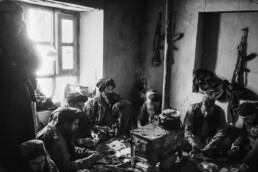
2nd Prize
Anthony WALLACE
AFP
Hong Kong, une révolte populaire
HONG KONG
3rd Prize
Laurent VAN DER STOCKT
Le Monde
Contestation irakienne : les jeunes exigent le changement
IRAQ
TELEVISION TROPHY – INTERNATIONAL JURY
AWARDED BY AMNESTY INTERNATIONAL
1st Prize
John SUDWORTH and Wang XIPING
BBC
Les familles ouïghoures
CHINA-TURKEY
2nd Prize
Julie DUNGELHOEFF, Catherine NORRIS TRENT and Abdallah MALKAWI
France 24
Libye : piège infernal
LIBYA
3rd Prize
Nicolas JOXE, Abdulrazzak MADI, Fajr ORABY, Belal ALBAYUS, Obaida ALNABWANI and Nisal MUHANA
SMART NEWS/ARTE
Syrie : les civils sous les bombes près d’Alep
SYRIA
PHOTO TROPHY – PUBLIC’S CHOICE AWARD
SPONSORED BY THE FRENCH DEVELOPMENT AGENCY (AFD)
1st Prize
Anthony WALLACE
AFP
Hong Kong, une révolte populaire
HONG KONG
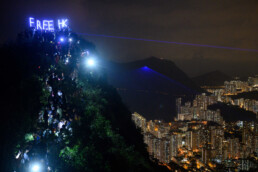
PRINT TROPHY – INTERNATIONAL JURY
AWARDED BY THE DEPARTMENT OF CALVADOS
1st Prize
Allan KAVAL
Le Monde
Dans le nord-est de la Syrie, la mort lente des prisonniers djihadistes
SYRIA
2nd Prize
Fritz SCHAAP
Der Spiegel
Rain wars
CHAD
3rd Prize
Jack LOSH
Foreign Policy
Les gardes forestiers d’Afrique centrale sont aussi menacés que les animaux qu’ils protègent
CENTRAL AFRICAN REPUBLIC
RADIO TROPHY – INTERNATIONAL JURY
AWARDED BY THE D-DAY LANDING COMMITTEE
1st Prize
Sonia GHEZALI and Shahzaib WAHLAH
RFI
Afghanistan : après l’attaque de la maternité de MSF
AFGHANISTAN
2nd Prize
Gwendoline DEBONO
Europe 1
Une frappe, des fractures : la mort du Général Soleimani en Irak
IRAQ
3rd Prize
Emilie BAUJARD
RTL
Les indésirables d’Hassaké
SYRIA
YOUNG REPORTER TROPHY (PHOTO) – INTERNATIONAL JURY
AWARDED BY CRÉDIT AGRICOLE NORMANDIE
1st Prize
Anas ALKHARBOUTLI
DPA
La guerre en Syrie
SYRIA
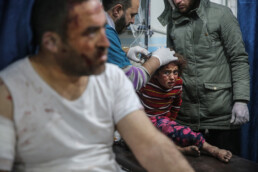
GRAND FORMAT TELEVISION TROPHY – INTERNATIONAL JURY
AWARDED BY BAYEUX CITY
1st Prize
Suzanne ALLANT, Yamaan KHATIB and Fadi AL-HALABI
Découpages pour Arte Reportage
Syrie, dans le piège d’Idlib
SYRIA
VIDEO IMAGE TROPHY – INTERNATIONAL JURY
AWARDED BY ARTE, FRANCE 24, FRANCE TÉLÉVISIONS
1st Prize
Olivier JOBARD
MAGNETO PRESSE pour ARTE/France 24
Yémen : à marche forcée
YEMEN
PRINT TROPHY – OUEST-FRANCE – JEAN MARIN
1st Prize
Allan KAVAL
Le Monde
Dans le nord-est de la Syrie, la mort lente des prisonniers djihadistes
SYRIA
TELEVISION TROPHY – REGIONAL PRIZE FOR STUDENTS AND TRAINEES OF NORMANDY
1st Prize
John SUDWORTH and Wang XIPING
BBC
Les familles ouïghoures
CHINA-TURKEY
Ed Vulliamy, Chair of the jury for the 27th edition
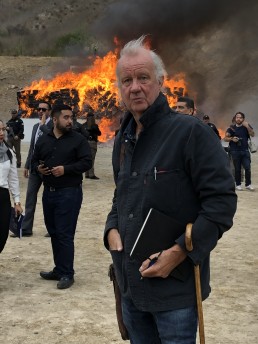
© Jorge Fregoso – Tijuana, Octobre 2019
“I don’t see myself as a war reporter. I see myself as an anti-war reporter”
“I don’t see myself as a war reporter. I see myself as an anti-war reporter”
At the age of almost 66 Ed Vulliamy belongs to what journalists tend to refer to as the “Sarajevo generation”. He covered the conflicts of the 1990s in Slovenia, Croatia and Bosnia, and in Iraq, but it was by no means a foregone conclusion that he would enter the singular profession of war correspondent.
“I hate war: my father was a pacifist and his mother, Irish and a fierce republican who had lived through the war of independence, was too”, he explains. “But war keeps coming to me.” As a student of politics and philosophy at the university of Oxford, the young Ed was deeply affected by the events taking place in Northern Ireland. The Troubles provided a natural subject for his thesis, which became his first “war report”. After leaving university he joined the team of World in Action, the investigative current affairs programme produced by English regional channel ITV Granada (formerly Granada TV), and spent eight years covering the conflict in Northern Ireland for the programme. His first area of specialisation also led to his first awards, with one of his many documentaries earning him the Royal Television Society award in 1985. He left to go to Italy, to investigate and cover organised crime in Europe’s famous “Boot”. His employer the Guardian, with whom he would continue to work throughout his whole career, asked him to “keep an eye on Yugoslavia” from Italy. In the end Ed would keep more than an eye on the Balkans: between 1991 and 1995 he spent most of his time in this region racked by successive conflicts. The journalist who had “become a war reporter by accident” received numerous awards for his work in this perilous zone. Having witnessed some of the worst atrocities, Ed Vulliamy would provide testimony in 2006 at the International Criminal Court in The Hague, in Holland, corroborated by footage filmed in the concentration camps for his documentary Omarska’s Survivors: Bosnia 1992. Facing him in the dock was Slobodan Prajlak, the man who had received him at the Dretelj camp 13 years earlier. At that moment the “accidental“ war reporter became the first journalist since the Nuremberg trials to testify in a war crimes tribunal.
“I don’t really go to war, war comes to me”
“I don’t really go to war, war comes to me”
At the end of the 1990s it was “Ciao, Italia!” Ed left for the United States where The Observer, sister title to The Guardian, had asked him to be its U.S. correspondent. He had already covered many topics in America for the British Sunday paper during the 1990s. This time he was able to return to his speciality, investigating organised crime and drug trafficking along the U.S.-Mexican border. The result was the book Amexia, War Along the Borderline, which received the prestigious Ryszard Kapuscinski Award in 2013. In 2001, when he was based in New York, he found himself in the front line when the attacks on the World Trade Center took place: once again “war came to [him]”. He later covered the conflict in Iraq for The Observer but had found himself “censored or ignored” when he tried to publish articles bringing to light the false information being propagated prior to the war and the non-existence of weapons of mass destruction. His determination and desire to reveal the truth are portrayed in Gavin Hood’s 2019 film Official Secrets, where he is played by the Welsh actor Rhys Ifans.
“To be a good journalist and especially a good war reporter, you have to be a little mad”
“To be a good journalist and especially a good war reporter, you have to be a little mad”
When asked how a journalist who has become a war correspondent by accident can be so committed and driven, Ed Vulliamy turns the question round: “What else to do?” He adds, with modesty, “It is our job to write or film the truth, however uncomfortable that is. In fact I think that’s how we measure professionalism in our work: by doing the best we can.” Measuring professionalism: that’s the big challenge in his upcoming role as chair of the international jury of the 27th Bayeux award for war correspondents. The journalist – who also writes articles and books on such diverse topics as football, painting and music – admits to feeling nervous: “I hope I’ll be up to it. It’s the Oscars of war reporting! It’s a huge responsibility and I’m honoured”.
“I think our definition of war may change as the 21st Century proceeds.
The wars my brave and amazing colleagues have mostly covered are like the wars of history, dragged into our time.
But what are we to make of new kinds of war in, say, Mexico, where the death toll is three times that of Bosnia, and the number of disappeared 50 per cent higher than all the Balkan wars, 1991-9? Yet in this war, which has killed more journalists than any other – people go to market, to school, to Mass; the football league functions well, the universities are good – war in apparent ‘peacetime’. What are we to call the gangland battlefields of El Salvador and Honduras, and refugees from ‘drugs wars’?
Academics use the term ‘slow violence’ to describe many of the world’s conflicts. Young people – journalists, readers and viewers – will include refugees and migration from climate crisis, and future wars over water and resources, as wars as much as any other – part of that time-long war between humankind and nature that will dominate coming generations. What are we to call the violent obliteration of the last indigenous existences, and assaults on indigenous lands and minorities? Journalists are being killed for reporting these stories too.
Where does systematic violence against women fit in to our definitions of war: femicidio in the Americas, the cult of gang rape in India?
That “war between the man and the woman*’ as Leonard Cohen called it!
We cannot call all violence ‘war’ – that would be ridiculous – and focus on warfare is what raises Bayeux to a level of honour above all other awards for journalism.
But I do think young people will want us to be less conventional with regard to what we call ‘War’, and, logically, war reporting.” — Ed Vulliamy
1954 ❱ Ed Vulliamy was born in Notting Hill, London
1979 ❱ Joined English regional channel ITV Granada (formerly Granada TV)
1985 ❱ Won the RTS Journalism Award for his documentary on Ireland
1986 ❱ Joined British newspaper The Guardian
1991 ❱ Covered the war in Iraq
1991-1995 ❱ Covered the wars in the Balkans
1992 ❱ Granada Television’s What the Papers Say Foreign Correspondent of the Year
1992 ❱ British Press Awards International Reporter of the Year
1992 ❱ Amnesty International Media Award
1994 ❱ James Cameron Award
1997 ❱ British Press Awards International Reporter of the Year
2001 ❱ Covered the 11 September attacks in New York
2003-2006 ❱ Covered the war in Iraq
2006 ❱ Became the first reporter since the Nuremberg trials to testify before the International Criminal Court in the Hague
2013 ❱ Won the Ryszard Kapuscinski Award for his book Amexica: War Along The Borderline
2015 ❱ Publication of the book Everything Is Happening: Journey into a painting on the masterpiece by Velázquez. He had completed the book for his friend, author Michael Jacobs.
2016 ❱ Nominated for the Ryszard Kapuscinski Award for his book The War Is Dead, Long Live the War, Bosnia: The Reckoning.
2018 ❱ Publication of the book When words fail: a life with music, war and peace (Louder Than Bombs in the United States)
2019 ❱ Was played by actor Rhys Ifans in Gavin Hood’s film film Official Secrets
2020 ❱ Made an Honorary Fellow of Goldsmiths College, London
2020 ❱ Second, updated edition of the book Amexica: War Along he Borderline, ten years after its first publication
Call for candidates
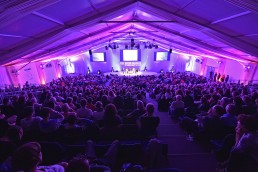
The Bayeux Calvados-Normandy award for war correspondents rewards reports about a conflict situation or its impact on civilians, or news stories involving the defence of freedom and democracy.
The report must have been made between 1 June 2019 and 31 May 2020. A €7,000 prize is awarded in each category.
The reports must be submitted to the following address by June 15th 2020: info@prixbayeux.org with a link to download the entry
The categories of media represented are: radio – photography – television (short and long formats) – written press and the young reporter prize (photo this year)
TEN PRIZES ARE AWARDED
Seven prizes awarded by the international jury
- Written Press Prize sponsored by the Calvados Department – €7,000
- Television Prize sponsored by Amnesty International- €7,000
- Radio Prize sponsored by the D-Day Landing Committee – €7,000
- Photo Prize sponsored by Nikon – €7,000
- Grand format Television Prize sponsored by the town of Bayeux – €7,000
- Young reporter Prize sponsored by Crédit Agricole Normandie – €3,000
- Video image prize sponsored by Arte, France 24 and France Télévisions – €3,000
Three special prizes
- The Ouest-France – Jean Marin Prize (written press) – €4,000
- The Public Prize (photo) sponsored by the Agence Française de Développement – €3,000
- The Normandy Region secondary School Students’ Prize (television) – €3,000
REGULATIONS
• The Young Reporter’s Award: in 2020: the category is photo. Since there is a different category according to the years, the presented story must have been realized between 1 June 2018 and 31 May 2020.
• Written press category: the application must be made up of an article or a series of 1 to 5 articles on the same subject.
• Television category: the length of the report must be between 1 minute 30 seconds and 6 minutes. The report submitted must be identical to the broadcast piece.
• Grand format television category: the length of the report must be between 6 and 30 minutes. The report submitted must be identical to the broadcast piece.
• Radio category: the length of the report must be between 1 minute and 6 minutes. The report submitted must be identical to the broadcast piece.
• Photo category: The application comprises a report made up of 8 to 15 photos.
Workshop Nikon – Le Manoir

With over a century of existence and by virtue of its values and commitment, supporting photojournalists is part of Nikon’s DNA.
In the framework of the Bayeux award for war correspondents, the brand offers to pay for 12 participants for the training "REPORT IN DANGEROUS ZONES" of the Manoir created by France Médias Monde.
In association with INA (the French national audiovisual archive) and with the support of Reporters without borders, the Manoir will soon have trained almost 360 reporters and information technicians and collaborates with many media like Le Monde newspaper, Arte, Canal + and the French public television channels, among others. The training provided by the Manoir is now recognised as the reference standard in its field.
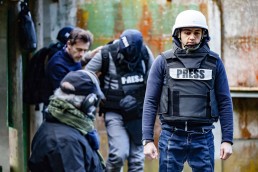
While it is obvious that research and information-sharing are essential, the safety of journalists on assignment has to be both the primary concern and the starting point in the editorial process.
Because the journalist is the principal player in his or her own safety, the Manoir provides specific training and methodologies given by journalists to journalists, and brings in leading experts in the fields of health, emergency rescue and psychology.
The effects of weapons, the dangers of mines and orientation skills are also taught by expert practitioners who are experienced in training news professionals.
By the end of the training course, the journalist situated in a danger zone is able to assess risks more accurately, to understand critical situations and to react more adroitly to accidents in the field.
By partnering with the Manoir, Nikon wants to support talented young photojournalists in the exercise of their profession by giving them the best possible training.
To apply, candidates must send their entry, including a CV, a motivation letter and one or more productions of a photo report produced in dangerous zones, to securite.academie@francemm.com before August 30, 2020.
Visual
The 2020 visual is a photo from the 2019 winning report. This photograph taken by Patrick Chauvel for Paris Match, was part of his report shot in Baghuz, Syria in March 2019.
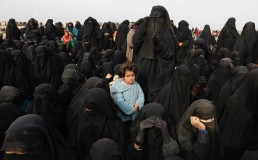
Caption: A little girl amid Jihadists’ wives assembled in the desert by the Kurds.
Patrick Chauvel
For over fifty years, Patrick Chauvel has photographed most of the conflicts around the world. He is one of the last of a generation of reporters who lived the Six Day War, Vietnam, Cambodia, Ireland, Iran, Lebanon, Panama, Afghanistan, Israel, Chechnya, Syria… His images have made the front page of the most prestigious media in the world. Author of numerous documentaries, he also wrote a book on the life of war reporter, success of bookstores: Rapporteur de guerre.
© Bayeux Award photo 2019 – Patrick Chauvel
26th edition of the Bayeux Calvados-Normandy Award: results
More than forty war correspondents have gathered in Bayeux on October 11th and 12th to debate and award trophies in the following categories: photo, print, radio, television, grand format television, young reporter (print) and video image. Three honorary awards have been attributed: the Regional prize for students and trainees of Normandy (television), the Public’s Choice award (photo) and the Ouest-France – Jean Marin prize (print). Presided by Gary Knight, the international jury of the 26th edition of the Bayeux Calvados-Normandy Award for war correspondents has reached its verdict…
“In every category, the jury converged on a few stories, there wasn’t a lot of dispute. We had a really great conversation amongst the jury, interesting, lively and with very good humour. Plus it is wonderfull to see my colleagues and it is also great to know what they have to say about that work. We can challenge each other and I love having this conversations. It makes it all smarter.“
Gary Knight
PHOTO TROPHY – INTERNATIONAL JURY
AWARDED BY NIKON
1st Prize
Patrick CHAUVEL
Freelance for PARIS MATCH
Syrie, la fin de Baghouz
SYRIA
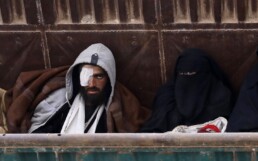
2nd Prize
Rodrigo ABD
ASSOCIATED PRESS
A caravan
MEXICO
3rd Prize
Andrew QUILTY
AGENCE VU
Quand la guerre rentre à la maison
AFGHANISTAN
TELEVISION TROPHY – INTERNATIONAL JURY
AWARDED BY AMNESTY INTERNATIONAL
1st Prize
Orla GUERIN, Lee DURANT and Nicola CAREEM
BBC NEWS
Yémen : un bus touché par une frappe aérienne
YEMEN
2nd Prize
John SUDWORTH and Wang XIQING
BBC NEWS
Les camps d’internement pour les musulmans en Chine
CHINA
3e Prix
Fausto BILOSLAVO
RETE 4
Guerre en Libye
LIBYA
PHOTO TROPHY – PUBLIC’S CHOICE AWARD
SPONSORED BY THE FRENCH DEVELOPMENT AGENCY (AFD)
1st Prize
Patrick CHAUVEL
Freelance for PARIS MATCH
Syrie, la fin de Baghouz
SYRIA

PRINT TROPHY – INTERNATIONAL JURY
AWARDED BY THE DEPARTMENT OF CALVADOS
1st Prize
Fritz SCHAAP
Der Spiegel
An epidemic and a war
DEMOCRATIC REPUBLIC OF CONGO (DRC)
2nd Prize
Wolfgang BAUER
Die Zeit
L’ordre
AFGHANISTAN
3rd Prize
Maggie MICHAEL
ASSOCIATED PRESS
Yémen, la sale guerre
YEMEN
RADIO TROPHY – INTERNATIONAL JURY
AWARDED BY THE D-DAY LANDING COMMITTEE
1st Prize
Sami BOUKHELIFA
RFI
Voyage au bout du califat
SYRIA
2nd Prize
Sophie PARMENTIER
France INTER
Françaises, mère et fille, dans une prison de Bagdad
IRAQ
3rd Prize
Matthieu MONDOLONI
France INFO
Kinan, l’enfant esclave de Daech
SYRIA-IRAQ
YOUNG REPORTER TROPHY (PRINT) – INTERNATIONAL JURY
AWARDED BY CRÉDIT AGRICOLE NORMANDIE
1st Prize
Wilson FACHE
L’ORIENT-LE JOUR / THE NATIONAL NEWSPAPER / VICE
Gaza, année noire
GAZA
GRAND FORMAT TELEVISION TROPHY – INTERNATIONAL JURY
AWARDED BY BAYEUX CITY
1st Prize
Clément GARGOULLAUD and Shafat FAROOQ
Babel Press for Arte Reportage
Cachemire : les visages de la colère
INDIA
VIDEO IMAGE TROPHY – INTERNATIONAL JURY
AWARDED BY ARTE, FRANCE 24, FRANCE TÉLÉVISIONS
1st Prize
Clément GARGOULLAUD
Babel Press for Arte Reportage
Cachemire : les visages de la colère
INDIA
PRINT TROPHY – OUEST-FRANCE – JEAN MARIN
1st Prize
Fritz SCHAAP
Der Spiegel
An epidemic and a war
DEMOCRATIC REPUBLIC OF CONGO (DRC)
TELEVISION TROPHY – REGIONAL PRIZE FOR STUDENTS AND TRAINEES OF NORMANDY
1st Prize
Leo RAMIREZ, Jesus OLARTE, Yorman MALDONADO, Carlos REYES, Natasha VAZQUEZ and Edinson ESTUPINAN
AFP TV
Venezuela: crisis at the border
VENEZUELA

